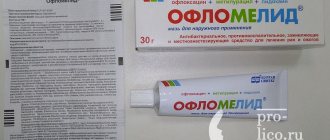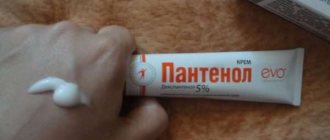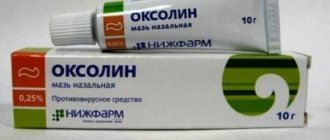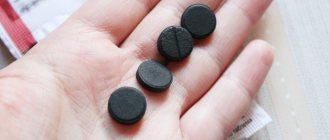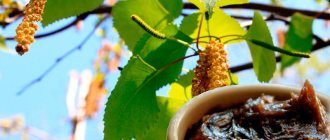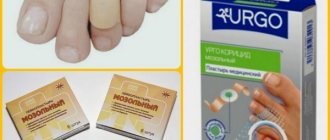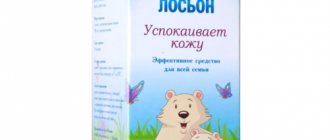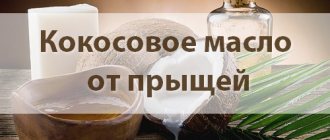In the struggle for healthy skin, people are divided into two camps. Some prefer traditional medicine recipes. Others trust pharmaceutical drugs, including “Baneotsin” for acne on the face enjoys stable popularity.
The product is produced by the Austrian pharmaceutical concern Sandoz GmbH in the form of ointment and powder.
It has a minimum of contraindications and has an effective effect on acne, boils, and purulent rashes.
Release forms, composition and description
The medicinal substance Baneocin is used for antibacterial effects on the skin.
Release forms:
- Powder for external application - the substance has a yellow color and a specific odor. For convenient application, the powder tube has a special dispenser. The volume of a plastic jar is 10 g;
- Ointment - thick consistency for external use. Produced in aluminum tubes, 20 grams each, the color of the cream is light yellow and may have a pungent odor.
Ointment Baneocin Baneocin powder
The powder has the following active ingredients:
- Bacitramine;
- Neomycin;
- Starch;
- Magnesium oxide.
The ointment has the following active ingredients:
- Bacitramine;
- Neomycin;
- Paraffin;
- Lanolin.
The choice of drug form depends on the individual characteristics of the body and the complexity of the disease. Most often performed by the attending physician.
Details about the drug
Baneocin is a combined antimicrobial agent that is used externally. The drug contains two powerful antibacterial substances: bacitracin and neomycin, which potentiate the pharmacological properties of each other when used together. Most often, this medicine is used in the treatment of skin infectious pathologies and wounds received at work and during sports. But baneocin also has a noticeable positive effect on acne.
Baneocin in powder form
Baneocin powder
Baneocin in powder form includes in its composition (active substances are indicated in terms of 1 gram of medicine):
- bacitracin – 250 IU;
- neomycin – 5000 IU;
- corn starch;
- magnesium oxide.
The medicine is a white or yellowish fine powder.
Baneocin in ointment form
Baneocin ointment
Baneocin ointment includes (active substances per 1 gram of drug):
- bacitracin – 250 IU;
- neomycin – 5000 IU;
- soft white paraffin;
- lanolin.
The external agent has the form of a yellowish ointment with a faint odor.
Indications for use
Baneocin is recommended to be used after a special type of diagnosis, which allows us to identify the cause of the problem.
Most often prescribed for the following problems:
- Inflammatory formations on the skin with purulent impurities;
- Trophic type ulcers
- Infections caused by staphylococcus bacteria;
- Dermatitis of various types;
- First and second degree burns
- For wound healing after surgical interventions;
- Wounds with purulent formations;
- Eczema of varying severity;
- Comedones and subcutaneous pimples.
It is also recommended to be used as an antibacterial substance against various types of abrasions and skin damage.
Drug interactions
During systemic absorption of Baneocin, it is prohibited to use aminoglycoside antibiotics or cephalosporins, as there is a high probability of developing nephrotoxic reactions.
The combination of this drug with Furosemide or ethacrynic acid can cause oto- or nephrotoxic reactions.
During systemic absorption of Baneocin, it is not recommended to prescribe opioid analgesics, anesthetics and muscle relaxants, since in this case the risk of neuromuscular blockade increases.
Positive properties of the drug and its effect
The use of the substance Baneocin allows you to achieve the following positive properties:
- The drug has a broad effect on the skin and helps eliminate various diseases of the epidermis;
- Antibiotics that are included in the composition are not addictive and can be used for a long time without reducing effectiveness;
- The active components of Baneocin do not penetrate deeply , therefore they have practically no ability to cause side symptoms;
- The result is achieved very quickly and lasts for a long time;
- The drug has the property of activating the natural processes of restoration of damaged cells and blocking their reoccurrence.
The drug can be used both locally and for large areas as directed. Does not have a negative effect on healthy cells upon contact during treatment.
Penetrating into the layers of the epidermis, it quickly eliminates harmful microbes and restores damaged cells. It is well tolerated by the body, so it can be used at an early age.
Advantages and disadvantages of application
A substance for external acne treatment has the following positive and negative qualities.
| Advantages: | Flaws: |
|
|
The effect of a substance on the skin may depend on the characteristics of the body and proper use, depending on the degree of damage to the skin.
Side effects
"Baneocin" is practically invisible on the skin and does not leave an oily film or unpleasant sensations when used.
If you apply it to rashes or affected areas pointwise , the drug will enter the blood in minimal quantities and will not affect the functioning of the kidneys, heart muscle, or nervous system.
In rare cases, in case of overdose, irritation, itching, and dry skin are observed in the treated areas. The use of the drug in case of individual intolerance may result in eczema.
If problems arise, you should stop using the product and immediately consult a dermatologist .
How to use Baneocin correctly?
The result largely depends on compliance with the rules of application. Depending on the release form, there are instructions for use that allow you to achieve the highest level of effect in the treatment of acne.
Baneocin ointment
To treat acne with Baneocin ointment, it is recommended to follow the following algorithm of actions:
- Clean the skin with water or a special product;
- Apply the drug precisely to each inflamed area;
- For a large number of pimples, apply the ointment in a thin layer, avoiding the mucous membranes;
- Leave until completely absorbed and dry;
- It is recommended to apply the ointment before going to bed once a day;
- The course of treatment depends on the severity of the disease, but not less than 7 days;
- It is recommended to use the ointment for several days after acne is eliminated.
When treating with Baneocin ointment for more than 3 weeks, it is recommended to take a break and then repeat the course of treatment.
Powder
To use Baneocin powder, it is recommended to follow the following instructions:
- Cleanse the skin of the face with water or a special preparation without alcohol;
- Using a dispenser, remove a small amount of the substance into the palm of your hand and apply it to problem areas using your fingertips;
- Gently massage the powder into the skin;
- Apply before bed once a day;
- After application, a film forms on the skin, which must be removed in the morning by washing;
- The duration of acne treatment is up to 15 days, after which you should definitely take a break.
For large areas of acne on the skin, the use of powder can be increased up to two times on the recommendation of the attending physician.
Description of the drug "Baneocin"
The drug "Baneocin" is based on the antibiotics bacitracin and neomycin . Their combined action helps get rid of pathogens (staphylococci, streptococci, actinomycete fungi, gram-negative bacteria) that provoke inflammatory processes in the skin.
"Baneocin" quickly eliminates inflammation in areas of any size if they are caused by microorganisms sensitive to the antibiotics in its composition.
Additional components of the drug ( lanolin and soft paraffin ) ensure its comfortable application.
"Baneocin" is intended for external use; it is produced in two forms :
- powder (yellowish thick mass) in 10-gram plastic jars with a dispenser,
- homogeneous yellowish ointment with a pronounced odor, packaged in 20-gram aluminum tubes.
Baneocin powder or ointment for acne is applied to damaged skin. Once in the skin, the antibiotics bacitracin and neomycin fight bacteria at the local level and gradually overcome skin imperfections.
The drug also has a drying effect , and after just a few uses you can notice a positive result. The product copes especially well with inflammatory acne.
When used according to the instructions, the drug enters the blood in minimal doses and is quickly eliminated from the body .
There is no need to worry about addiction, since bacteria are not able to form resistant strains to its components.
The maximum concentration of the active substance is observed at the site of application, which allows you to restore an even tone to the skin and get rid of rashes without affecting healthy areas.
"Baneocin" in the treatment of skin pathologies
"Baneocin" is prescribed for the treatment of infectious and inflammatory diseases caused by microorganisms sensitive to the antibiotics neomycin and bacitracin.
It is safe, effective, has a minimum of contraindications, and therefore is often used in the treatment of pustules and acne in the face, chest, and back.
"Baneocin" is actively used in the treatment:
- boils,
- abscesses,
- purulent acne,
- carbuncles,
- streptoderma,
- purulent infections (folliculitis, pyoderma).
Contraindications
"Baneocin" acne powder and ointment are safe for patients of any age.
However, they have a number of contraindications , which are taken into account before starting the treatment course. Contraindications include:
- a large area of pustular lesions (absorption of a large amount of medication into the blood can provoke hearing loss)
- pregnancy and breastfeeding (components can penetrate the placenta and mother’s milk),
- diseases of the kidneys, blood vessels, heart, excretory system,
- disorders of the neuromuscular system, eye pathologies,
- allergy to antibiotics, intolerance to aminoglycosides.
In case of contraindications, the doctor will help you find analogues . There are no drugs that contain active ingredients like Baneocin.
However, there are medications with a similar therapeutic effect: Neomycin, Gentamicin, Bonderm ointments, Fuzidin gel, Fusiderm cream and others.
Important Features
To achieve more visible results in treatment, it is necessary to adhere to the following important features:
- Do not use the substance in large quantities ; it is recommended to strictly follow the instructions for use. Otherwise, increased dryness of the epidermis may occur;
- For wounds and inflammatory formations that tend to secrete fluid, it is recommended to use powder;
- When using powder to treat acne, do not apply the substance to the eyes or mouth;
- Before starting treatment, you must consult a dermatologist and undergo diagnostics;
- In the presence of liver and kidney diseases, the dosage should be reduced and the patient’s well-being monitored;
- When treating acne, crusts may form , which are not recommended to be eliminated;
- Before starting acne treatment, it is recommended to test for individual sensitivity to the components.
It is not recommended to use Baneocin ointment against acne before going outside, as direct sunlight can cause irritation and burns on the epidermis.
When shouldn't it be used?
The ointment is usually well tolerated by patients, including children. She doesn't bake or pinch. But this is a rather strong antibiotic, it has contraindications. These include:
- violation of the excretory function of the kidneys (with renal or heart failure);
- large affected area;
- hypersensitivity to the components of the drug;
- disorders of the cochleovestibular apparatus (damage to the inner ear and auditory nerve).
Increased caution when using Baneocin should be exercised in patients with neuromuscular pathologies (myasthenia gravis, acidosis). The ointment is allowed to be used by pregnant and lactating women, but only after consultation with a doctor.
Use during pregnancy and lactation
The drug Baneocin can be used during pregnancy and breastfeeding.
However, the dosage is selected individually, taking into account the following features:
- Apply Baneocin point-wise only to the location of the problem;
- Do not use the substance in the first trimester of pregnancy;
- Do not use Baneocin for a long time;
- Use only in cases of urgent need, since the existing antibiotics in the substance tend to negatively affect the health of the fetus;
- When using Baneocin during breastfeeding, care should be taken to ensure that the substance does not come into contact with the baby’s mucous membranes.
During treatment with Baneocin, it is recommended to carefully monitor the well-being of the pregnant woman.
Use of ointment in adults
Does Baneocin help with boils? Reviews from doctors say that this drug is quite effective in treating any purulent lesions. After treating the affected areas, the patient’s recovery occurs very quickly. As a result of this, there is no need to cut out the boil with a scalpel.
It should also be noted that Baneocin ointment helps against lichen. Reviews from dermatologists indicate that regular use of this drug contributes to a speedy recovery of the patient.
By the way, this medication is often used for diseases such as acne. "Baneocin" for acne (reviews about the drug are extremely positive) are used once a day, before bed.
Use in childhood
The use of Baneocin in childhood requires compliance with the following features:
- The substance is used from the first days of life on the recommendation of the attending physician;
- Application is carried out only on a specific area of the body, prohibited for large areas;
- It is recommended to use powder to treat the umbilical cord;
- Use is prohibited for diseases of internal organs, as well as for allergic dermatitis in a child.
Pediatricians recommend short-course treatment with Baneocin under the supervision of a specialist.
Does it help?
Baneocin is a relatively strong remedy. But using it alone will not help cure acne with purulent rashes.
Treatment should be comprehensive and include careful daily care, proper nutrition, the use of medicinal cosmetics, proper daily routine and, if necessary, drug therapy.
Only an integrated approach will effectively cope with serious facial skin problems. And the use of Baneocin will speed up this process.
Numerous positive reviews indicate its effectiveness and prove that its use helps in the treatment of purulent acne.
Possible analogues
If necessary, medications can be prescribed that have a similar effect on the human body as Baneocin.
The most effective include:
- Bactroban is an ointment that contains an antibiotic for the treatment of acne and other types of skin diseases. It has antibacterial and healing properties on the skin. Cost 440 rubles ;
- Levomekol - has similar effects on the skin and will help get rid of acne. Prescribed with caution during pregnancy. It has the quick property of relieving inflammation and destroying bacteria that cause purulent formations. Cost 60 rubles ;
- Lincomycin is a topical antibiotic used to eliminate inflammatory formations, including acne. The drug is approved for use from the age of 1 month as prescribed by a pediatrician. Cost 260 rubles .
Bactroban Levomekol Lincomycin
When using Baneocin analogues, it is necessary to study in detail possible complications and adverse reactions of the body.
Or maybe it’s still green? About drug analogues
In fact, brilliant green, although used for injuries, is not an analogue of Baneocin ointment. An alternative to this drug can only be drugs that also contain an antibiotic. One of them is Gentamicin ointment. It is also used for burns, trophic ulcers and other injuries associated with a bacterial infection. It costs only 40 rubles, but is not suitable for pregnant and lactating women. Another well-known analogue is Bactroban ointment. This is a broad-spectrum antibiotic with the same indications, but it costs more - 430 rubles.
The most famous drug that can replace Baneocin is chloramphenicol ointment with the antibiotic. This is a proven and effective remedy, and it costs only 60 rubles. Another inexpensive “competitor” is syntomycin ointment. It also contains an antibiotic and copes well with purulent skin lesions, and its price is 60-70 rubles. - won't hurt your wallet.
Baneocin in masks for acne treatment
Some masks for acne treatment include Baneocin. Such remedies should be used only after consulting a doctor. Several effective recipes are given below.
Mask No. 1
Ingredients:
- Baneocin powder from one jar,
- 5 sachets of Streptocide, 2 grams each,
- 20 tablets of chloramphenicol,
- 20 tablets of Furacilin,
- 20 Aspirin tablets,
- 5 tablets of calcium gluconate,
- 3 teaspoons of cosmetic clay (preferably white).
The listed components must be ground in a coffee grinder and mixed. Pour the resulting powder into a dry, clean container and use as needed.
To prepare the mask, pour 2 teaspoons of the mixture into a container, add 1 dessert spoon of water and mix until mushy. Apply to facial skin. Wash off after 20 minutes. After this, it is not recommended to use any other external agents.
Mask No. 2
Ingredients:
- Baneocin powder on the tip of a knife,
- 4 tablets of Levomycetin,
- 4 tablets of Aspirin,
- 6 tablets of Metronidazole,
- 5 tablets of Erythromycin,
- 5 Tavegil tablets,
- 1 bottle of one percent salicylic acid,
- 1 bottle of calendula tincture,
- 1 bottle of boric acid,
- 2 sachets of Streptocide.
Mix all the ingredients and apply the composition to the skin. Leave for 10-15 minutes, rinse. Do not apply any external products for some time, after which you can use non-greasy moisturizers to prevent drying of the skin.
Mask No. 3
Baneocin powder for acne can be mixed with tea tree oil. This mask has a delicate effect on the skin, but is very effective in combating inflammatory skin rashes. In addition to the detrimental effect on pathogenic bacteria, this product triggers restoration processes that improve the condition of the skin.
Thus, Baneocin is an extremely effective external remedy for the therapeutic correction of acne. But you need to remember that this drug should be used only after consulting a specialist.
Contraindications and precautions
Contraindications to the use of a particular ointment are indicated in the annotation to it. They must be observed.
Precautionary measures when treating hematomas are:
- preventing ointment from getting on the wound if this is prohibited according to the instructions for it;
- application of a warming agent is permitted no earlier than 8 hours after receiving a bruise;
- if there is severe pain and inability to move fully, you should seek medical help;
- a lump that persists after a bruise for more than 14 days requires seeking medical help.
Reducing a bruise with ointment is a doable task, and with the right choice of remedy for bruises, you can restore normal condition in a short time.

